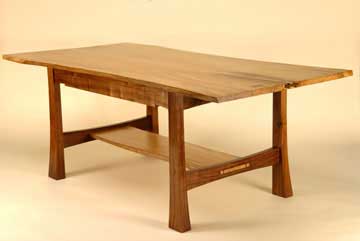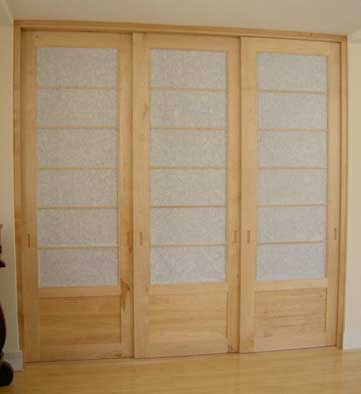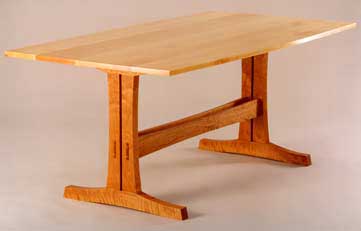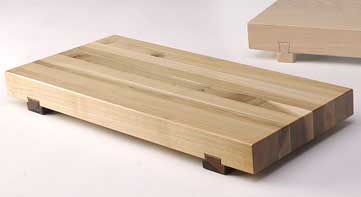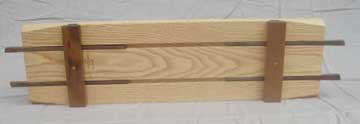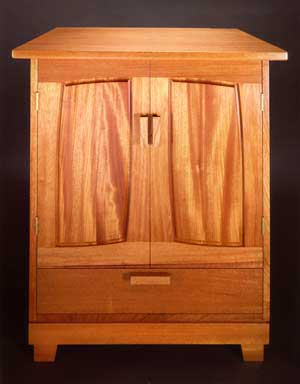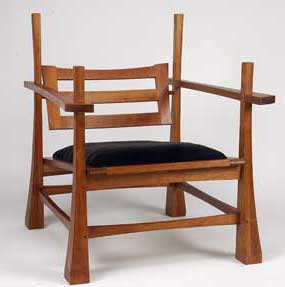
Corwin Butterworth has a distinctive name: the memorable sort that would fit an artist, a musician, or even a furniture maker. Perhaps that helps explain what led this renaissance man of the art world to divide his time with all three of those artistic pursuits. The main one, though, and what he considers his day job, is furniture making, and curiously, his mother’s remarriage was instrumental in steering him that way.
“When I was a kid,” Corwin recounted, “my dad was a hobby farmer. He had a couple horses and cows and grew some vegetables. His day job was as an English professor, but by the time I was born he was 56, and only worked for another couple years before he retired to farm more or less full-time.
“When I was 12, my mother remarried, this time to a noted studio furniture maker, John McAlevey. Although I never worked with him, his work affected me aesthetically. At the time, I was not really interested in woodworking. In fact, through college I was an art major doing mostly painting, and did that two years after college. After not selling anything for two years, I decided to become a woodworker instead.
“In 1998, I took a two-week summer class at Rhode Island School of Design in furniture making. At the close of the class, the teacher hired me to work in his furniture shop, and I did that on and off for the next eight years. I also started my own furniture making studio, and set up my own shop in 2003. Business has been varied and surprising. When the economy was crashing, I was my busiest, but things have tapered off. Nor does buying always coincide with interest.
“A good example is my Swivel Back Lounge chair. When I take the chair to shows, everyone seems to love it, but so far, no one has ordered one. I suspect I could sell one off the floor of a show if I had one that was something other than a sample. My original thought was to make a chair that mimicked a four-poster bed. Originally it had a canopy over it, but later morphed into what it is today. Though it is lightweight and looks delicate, it is actually quite strong and very comfortable to sit in.”
At times he will make custom pieces that start with the customer choosing the wood. “One table I made was from an elm tree that a customer had cut down, sliced and stored it in their garage for seven years,” Corwin told me. “Elm is not the most ideal wood for a table, but I agreed to work with it. Because they use their dining table as a work area as well, the table has drawers set into the apron.”
He’s also run across some surprises with custom work, often late in the game. “I made a set of shoji screens for a customer who was building a new wing onto his house,” Corwin explained. “To separate the new from the old, they wanted screens that would let light go through, but still afford privacy. That was the first time I had done shoji screens, and did research in books to make it. Of course, when I went to install them, I discovered their wall was out of plumb.
“The trestle table is a simple design, but the customer wanted it to seat 10 people. In order to do that, I made the top wider than normal, and designed a double stretcher on the bottom. It wasn’t absolutely necessary, but it sets it apart from a traditional trestle table.”
Not one to be wasteful, Corwin finds ways of using even cut-offs. “Scrap wood often becomes cutting boards,” he explained, “typically with feet set into the bottom with a sliding dovetail to allow movement. A dowel in the middle centers the foot, but it is not glued in. Some of them also have dadoes on the underside of the board and corresponding notches on the feet. The notch is just large enough to snugly hold a pair of chopsticks. The cutting boards are an introductory piece that I hope will convince buyers to spring for something larger later. It has, in fact, worked a few times. I also do simple spice racks and small boxes for the same reasons.
“Interestingly, there is a gallery that opened up last fall in my area. I brought them some furniture, and showed them pictures of pieces in my house. In one photo they saw one of my paintings and suggested I hang those in the gallery as well. So far, they’ve sold three of my paintings along with some of my smaller wood items. They’ve asked me to do a show in August of both wood and paintings, and I plan to do new paintings for it. Of course, I haven’t painted since 2003, so that should be interesting.
“I’m also a musician. I play guitar, lap steel, dobro and mandolin in a group that uses bluegrass instruments to play rock music, and I just got a banjo for my birthday. We’ve done a couple of albums, but that’s the smallest segment of the equation.
“Both as a painter and a furniture maker, I am drawn to keeping things simple, so I focus on joinery combined with simple lines. I lean toward Shaker and Japanese designs rather than more ornate or elaborate ones. I prefer working only with solid wood, not plywood, in part because it is easier to repair, and because I like the idea of taking a piece of a tree and being the one to shape it into something. It just feels like it has more soul to me.”
That seems an entirely appropriate comment from one with talent in so many art forms.
